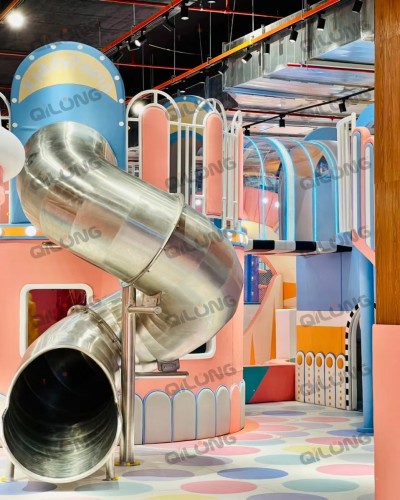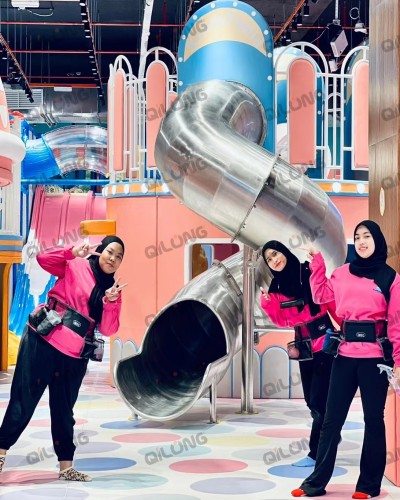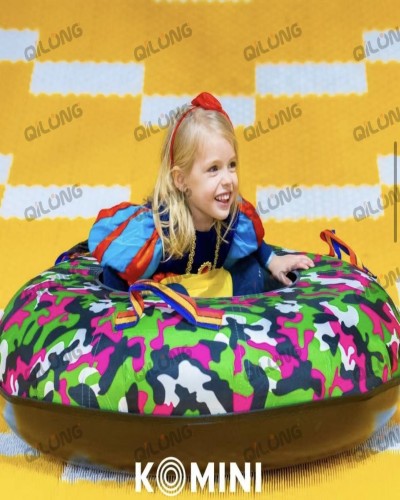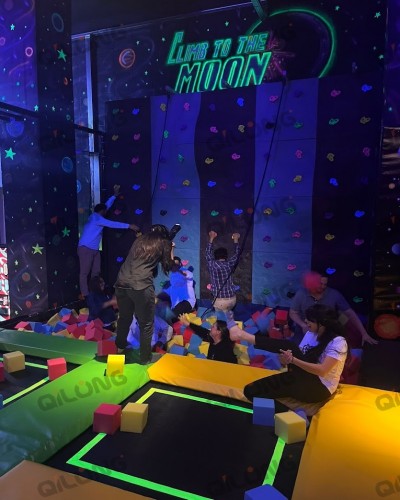As families seek more engaging and immersive entertainment options, indoor playgrounds are transforming into tech-enhanced environments that go far beyond plastic slides and padded ball pits. From interactive projection floors to augmented reality (AR) walls, technology is rapidly reshaping how children play—and how operators generate revenue.
At Qilong Amusement Equipment Co., Ltd., we’ve worked with clients in over 100 countries to integrate smart systems into traditional play areas, blending motion, learning, and fun. In this article, we explore the growing role of technology in kids indoor playgrounds, analyze cost-to-engagement impact, and share ideas for future-ready play spaces.
Game Walls:
Active Play Meets Digital Interaction
One of the most popular additions to modern indoor playgrounds is the interactive game wall. Children throw soft balls or wave their hands to hit targets on a projected screen. The game responds in real time with animations, points, or physical feedback.
Key benefits:
-
Promotes physical activity + cognitive coordination
-
Accommodates multiple age groups simultaneously
-
Can be themed (sports, space, math, dinosaurs) for educational play
Many trampoline park operators are adding game walls as side attractions to increase engagement in queue areas or toddler zones.
💡 Case Example: A client in Southeast Asia added two interactive game walls near the café and saw a 22% increase in average dwell time among family visitors.
Interactive Projection Floors:
Turning Ground into a Playground
Interactive floors use motion sensors and projectors to display digital games directly on the ground. Children run, jump, and dance on light-based effects—from popping bubbles to catching falling stars.
Why it works:
-
No physical contact = low maintenance
-
Easy to rotate content (seasonal themes, learning modules)
-
Captures attention in high-traffic areas like entrances or party rooms
These systems are increasingly common in china commercial indoor playground projects located in shopping malls, where first impressions drive walk-in visits.
📊 ROI Insight: A single floor projection unit (~$4,000–$7,000) can handle thousands of plays per month with minimal staff supervision.
Smart Scoring & Reward Systems: Gamifying the Playground
Technology isn’t just about visuals—it’s also about tracking behavior. Smart scoring systems use wristbands, QR codes, or RFID tags to monitor participation, assign points, and unlock digital rewards.
Features include:
-
Timed obstacle course results
-
Digital leaderboards for ninja tag challenges
-
Personalized scores on climbing walls or rope courses
Operators can gamify the entire experience, turning physical activity into a friendly competition that encourages repeat visits and peer sharing.
🔁 Engagement Boost: Locations using smart tracking report longer play sessions, especially when kids return to beat their previous scores.
Cost vs. Retention:
Is the Investment Worth It?
It’s natural to ask: are these technologies profitable, or just “wow” factors?
Here’s a comparison of typical hardware costs and average impact on user behavior:
| Tech Feature | Avg. Cost (USD) | Staff Needed | Typical Lifespan | Effect on Dwell Time |
|---|---|---|---|---|
| Game Wall (motion) | $6,000–10,000 | Low | 5+ years | +15–25% |
| Interactive Floor | $4,000–7,000 | None | 5+ years | +10–20% |
| RFID Scoring System | $3,000–6,000 | Medium (setup) | 3–5 years | +25–35% |
| AR/VR Headsets (limited) | $1,500–3,000/unit | Supervised | 2–3 years | +10–15% |
Takeaway: The return is less about direct ticket sales, and more about increasing session length, secondary spending, and repeat visits. Longer play = more snacks, more party bookings, more satisfied parents.
5. Making It Work: Tips for Integration
If you're planning to introduce technology into your kids indoor playground, consider the following tips:
-
 Start small & ExpandInstall one projection wall or RFID activity in a limited zone to measure engagement before scaling up.
Start small & ExpandInstall one projection wall or RFID activity in a limited zone to measure engagement before scaling up. -
 Rotate Content FrequentlyDigital games can become repetitive. Choose platforms with regular content updates or customizable themes.
Rotate Content FrequentlyDigital games can become repetitive. Choose platforms with regular content updates or customizable themes. -
 Mix Tech with Tactile PlayBalance screens with physical play structures—climbing, crawling, and cooperative tasks are still vital to child development.
Mix Tech with Tactile PlayBalance screens with physical play structures—climbing, crawling, and cooperative tasks are still vital to child development. -
 Monetize SmartlyBundle tech attractions into VIP packages, birthday events, or loyalty programs. Tech play should feel like a premium experience.
Monetize SmartlyBundle tech attractions into VIP packages, birthday events, or loyalty programs. Tech play should feel like a premium experience.
The Future:
From VR Labs to AI-Powered Play
Looking ahead, indoor playgrounds are exploring even more advanced tech:
-
AR treasure hunts using tablets or smart glasses
-
Voice-activated storytelling zones for interactive reading
-
AI-enabled behavior tracking to suggest games based on child mood or age
Though some may sound futuristic, many are already being piloted in high-end entertainment centers or tech-focused china commercial indoor playground developments.
Conclusion: Technology is the New Playground Partner
Integrating digital technology into indoor play isn’t about replacing physical fun—it’s about enhancing engagement, extending time-on-site, and offering new business models in a saturated market.
At Qilong Amusement Equipment Co., Ltd., we help clients build playgrounds with purpose. From climbing walls to immersive projection rooms, our goal is to balance safety, excitement, and return on investment.
✅ Want to bring smart play to your indoor space?
👉 Requst a Custom Playground proposal